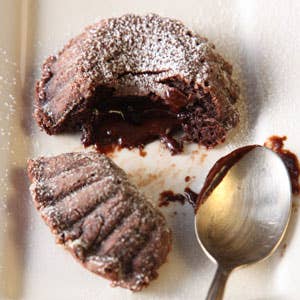
Why do certain dishes remain fixed on restaurant menus for decades while others come and go? The answer is simple: they are unwaveringly, irresistibly good. What's more, by virtue of their staying power, they offer windows onto the eras in which they were born. Here are nine of our favorite signature restaurant dishes from around the country, listed in order of the years they were invented.
1. Bookbinder's Famous Snapper Soup _(Old Original Bookbinder's, Philadelphia; 1865) _Turtle soup was to the 1860s what duck a l'orange was to the 1960s: the epitome of fine dining. This veal stock-based soup with delicate snapping turtle meat is prepared as it's always been at Bookbinder's. You can find versions of it at old-guard restaurants around the country, including the Cape Cod Room at Chicago's Drake Hotel, where, curiously, it's billed as "The Drake's Signature Bookbinder Soup".
2. Oysters Rockefeller _(Antoine's, New Orleans; 1889) _When Jules Alciatore of Antoine's invented this dish, oysters were all the rage in New Orleans and other coastal cities. As their popularity spread inland with refrigerated railcars, so did demand for elegant ways to prepare the shellfish. When chefs started copying the Antoine's dish, they smothered oysters in butter, spinach, bread crumbs, and other toppings and broiled them on the half shell. But the original recipe (still a closely guarded secret) calls for pureeing all of the ingredients into a rich paste and piping them into the oysters' shells before they are baked.
3. Lobster Savannah (Locke-Ober, Boston, Massachusetts; circa 1930) Though it originated down South, lobster Savannah has been inextricably associated with the Yankee restaurant Locke-Ober since the Great Depression. A mix of lobster, mushrooms, pimentos, sherry, bechamel, and parmesan that's baked in the lobster's shell, the dish is similar to other extravagant classics like lobster thermidor and lobster newburg. When Lydia Shire took over at Locke-Ober, in 2001, she introduced a lighter sauce and replaced the pimentos with fresh red bell peppers.
4. Orange Beef (Shun Lee Palace, New York City; 1971) There was a time when Chinese food in this country meant (Americanized) Cantonese food. With the opening of Shun Lee Palace on New York's Upper East Side in 1971, the savvy restaurateur Michael Tong made it his mission to expand people's notions of what a Chinese restaurant could be with sophisticated dishes from Shanghai, Beijing, Sichuan, and Hunan. Thus his orange beef, which pairs crisp-fried filet with bittersweet preserved orange, a take on a Hunan specialty. Nowadays, we rarely encounter a Chinese restaurant that doesn't serve it.
5. Baked Goat Cheese with Garden Lettuces (Chez Panisse, Berkeley, California; 1981) Though salads with medallions of warm, bread crumb-coated goat cheese are now somewhat of a cliche, the one served in Chez Panisse's upstairs cafe still tastes like the revelation it was when chef Alice Waters introduced it, 28 years ago. At the time, French-style goat cheese was largely unknown in the States, and baby lettuces came as a delicious shock to diners raised on iceberg and romaine.
6. House Smoked Salmon Pizza (Spago, Beverly Hills, California; 1982) Beginning in the late '70s, Wolfgang Puck put a distinctly glamorous spin on California cuisine, and with the opening of Spago, in 1982, he minted the genre of the "gourmet pizza". Puck says he created his most famous pie on the fly one night, when the actress Joan Collins ordered smoked salmon with brioche and he realized he was out of bread. Thinking fast, he covered a just-baked pizza crust with dill-infused creme fraiche, arranged cold smoked salmon on top, and finished it off with a generous dollop of caviar.
7. Chicken for Two Roasted in the Brick Oven (Zuni Cafe, San Francisco, California; 1987) Sometimes a dish has a seismic effect, not because of a radical combination of ingredients but simply because it's the best of its kind. The sublime chicken that Judy Rodgers roasts in a wood-fired oven and serves with a Tuscan-style bread salad at Zuni Cafe is a case in point. The secret? Salting the bird 24 to 72 hours in advance. The salt slightly cures the flesh, yielding succulent and intensely flavorful results.
8. Black Cod with Miso _(Nobu, New York City; 1994) _You could say that without this dish—which calls for a traditional Japanese technique of gently pickling fish in sweet saikyo miso—there would be no Nobu. It was a version of it at chef Nobu Matsuhisa's Los Angeles sushi restaurant that kept Robert De Niro coming back for more. De Niro eventually persuaded the chef to partner with him in opening Nobu in New York in 1994. Today, black cod with miso is a favorite at all 18 Nobu restaurants (and countless imitators) worldwide.
9. Jean-Georges Chocolate Cake (Jean Georges, New York City; 1997) Jean-Georges Vongerichten's most famous dessert is commonly listed on other chefs' menus these days as "molten chocolate cake" or "chocolate lava cake". On the face of it, the confection appears to be nothing more than an individual chocolate cake baked in a fluted mold, but dive in, and a luscious, oozing center reveals itself. Vongerichten claims he invented the dessert by accident when he underbaked a cake while working at the restaurant Lafayette in New York. Little did he know it would go on to become the signature dessert of the 1990s.
Keep Reading
Continue to Next Story










